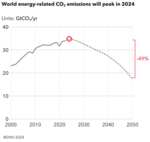News Release from International Energy Agency (IEA)
Wind Industry Profile of
Global energy demand to plunge this year as a result of the biggest shock since the Second World War
A new report released today by the International Energy Agency provides an almost real-time view of the Covid-19 pandemic’s extraordinary impact across all major fuels. Based on an analysis of more than 100 days of real data so far this year, the IEA’s Global Energy Review includes estimates for how energy consumption and carbon dioxide (CO2) emissions trends are likely to evolve over the rest of 2020.
“This is a historic shock to the entire energy world. Amid today’s unparalleled health and economic crises, the plunge in demand for nearly all major fuels is staggering, especially for coal, oil and gas. Only renewables are holding up during the previously unheard-of slump in electricity use,” said Dr Fatih Birol, the IEA Executive Director. “It is still too early to determine the longer-term impacts, but the energy industry that emerges from this crisis will be significantly different from the one that came before.”
The Global Energy Review’s projections of energy demand and energy-related emissions for 2020 are based on assumptions that the lockdowns implemented around the world in response to the pandemic are progressively eased in most countries in the coming months, accompanied by a gradual economic recovery.
The report projects that energy demand will fall 6% in 2020 – seven times the decline after the 2008 global financial crisis. In absolute terms, the decline is unprecedented – the equivalent of losing the entire energy demand of India, the world’s third largest energy consumer. Advanced economies are expected to see the biggest declines, with demand set to fall by 9% in the United States and by 11% in the European Union. The impact of the crisis on energy demand is heavily dependent on the duration and stringency of measures to curb the spread of the virus. For instance, the IEA found that each month of worldwide lockdown at the levels seen in early April reduces annual global energy demand by about 1.5%.
Changes to electricity use during lockdowns have resulted in significant declines in overall electricity demand, with consumption levels and patterns on weekdays looking like those of a pre-crisis Sunday. Full lockdowns have pushed down electricity demand by 20% or more, with lesser impacts from partial lockdowns. Electricity demand is set to decline by 5% in 2020, the largest drop since the Great Depression in the 1930s.
At the same time, lockdown measures are driving a major shift towards low-carbon sources of electricity including wind, solar PV, hydropower and nuclear. After overtaking coal for the first time ever in 2019, low-carbon sources are set to extend their lead this year to reach 40% of global electricity generation – 6 percentage points ahead of coal. Electricity generation from wind and solar PV continues to increase in 2020, lifted by new projects that were completed in 2019 and early 2020.
This trend is affecting demand for electricity from coal and natural gas, which are finding themselves increasingly squeezed between low overall power demand and increasing output from renewables. As a result, the combined share of gas and coal in the global power mix is set to drop by 3 percentage points in 2020 to a level not seen since 2001.
Coal is particularly hard hit, with global demand projected to fall by 8% in 2020, the largest decline since the Second World War. Following its 2018 peak, coal-fired power generation is set to fall by more than 10% this year.
After 10 years of uninterrupted growth, natural gas demand is on track to decline 5% in 2020. This would be the largest recorded year-on-year drop in consumption since natural gas demand developed at scale during the second half of the 20th century. The massive impact of the crisis on oil demand has already been covered in detail in our April Oil Market Report.
Renewables are set to be the only energy source that will grow in 2020, with their share of global electricity generation projected to jump thanks to their priority access to grids and low operating costs. Despite supply chain disruptions that have paused or delayed deployment in several key regions this year, solar PV and wind are on track to help lift renewable electricity generation by 5% in 2020, aided by higher output from hydropower.
“This crisis has underlined the deep reliance of modern societies on reliable electricity supplies for supporting healthcare systems, businesses and the basic amenities of daily life,” said Dr Birol. “But nobody should take any of this for granted – greater investments and smarter policies are needed to keep electricity supplies secure.”
Despite the resilience of renewables in electricity generation in 2020, their growth is set to be lower than in previous years. Nuclear power, another major source of low-carbon electricity, is on track to drop by 3% this year from the all-time high it reached in 2019. And renewables outside the power sector are faring less well. Global demand for biofuels is set to fall substantially in 2020 as restrictions on transport and travel reduce road transport fuel demand, including for blended fuels.
As a result of these trends – mainly the declines in coal and oil use – global energy-related CO2 emissions are set to fall by almost 8% in 2020, reaching their lowest level since 2010. This would be the largest decrease in emissions ever recorded – nearly six times larger than the previous record drop of 400 million tonnes in 2009 that resulted from the global financial crisis.
“Resulting from premature deaths and economic trauma around the world, the historic decline in global emissions is absolutely nothing to cheer,” said Dr Birol. “And if the aftermath of the 2008 financial crisis is anything to go by, we are likely to soon see a sharp rebound in emissions as economic conditions improve. But governments can learn from that experience by putting clean energy technologies – renewables, efficiency, batteries, hydrogen and carbon capture – at the heart of their plans for economic recovery. Investing in those areas can create jobs, make economies more competitive and steer the world towards a more resilient and cleaner energy future.”
- Source:
- IEA
- Author:
- Press Office
- Link:
- www.iea.org/...
- Keywords:
- IEA, global, energy demand, corona, COVID-19, drop, demand, record, carbon emissions, CO2, renewable energy, pandemic, impact, energy industry, decline, India, Europe, electricity


























